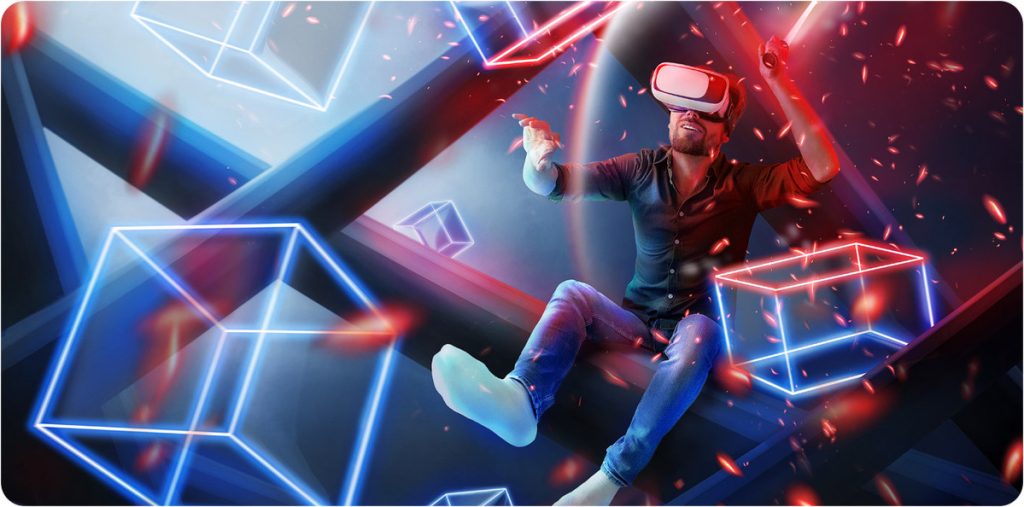The Most Important Technologies In Metaverse
Although the Metaverse sounds More Like A Science Fiction Concept, We Have To Face The Shocking Fact That The Metaverse Is Just As Real As The Internet.
Undoubtedly, Metaverse is a new world and must go through many trends, changes, and developments to become a regular and everyday concept like the Internet.
Therefore, it is essential to understand the critical technologies of the Metaverse to understand this universe and the steps it needs to take toward broader adoption.
With the passage of time and rapid changes in people’s lives, various methods for entertainment, shopping, watching movies, or socializing with friends emerge. Technologies like Metaverse help us to spend time with our friends and loved ones whenever we want instead of traveling long distances. In addition to being fun, the Metaverse can bring two people who live far apart closer together.
Currently, several technologies help the growth and development of Metaverse. In this article, we will mention five essential technologies in Metaverse which have played the most influential role in expanding this virtual world.
These five technologies are artificial intelligence, virtual reality, and augmented reality. Internet of Things، Blockchain, and abundant computing power. For this purpose, we will first briefly introduce each of these areas. Then we will mention the influence of each in advancing the Metaverse.
Artificial Intelligence (AI)

Artificial intelligence is one of the most critical technologies in the Metaverse. This technology has several roles in maintaining the efficiency of Metaverse. For example, AI can help continuously monitor servers to increase cyber security or provide more thoughtful responses. AI monitoring of servers can make them a safer environment against malicious actors.
Artificial intelligence has recently found an important place among the pioneers of cyberspace. A recent report by the business services company Deloitte (Deloitte) shows that 40% of companies use strategies based on artificial intelligence at the level of their organization. Also, for a long time, prominent companies such as Soul Machines have started investing in this field and developing it for virtual worlds.
When the AI engine is fed with historical data, it tries to arrive at new results by summarizing the previous outputs. At the same time, artificial intelligence production gets better feedback every time new data comes in. With new virtual worlds relying on artificial intelligence and removing the need for human intervention, this technology can significantly help the scalability of the Metaverse.
It is not harmful to mention that fast data processing with artificial intelligence can make improving scalability more prominent.
In addition to massive scalability, decentralization, infrastructure support, interactive user interface, improved accessibility, cyber security, more brilliant translations of programming languages, monitoring smart contracts, healthcare, and helping the gaming industry are just some of the applications of AI in the metaverse space.
Artificial intelligence helps human-computer interaction by recognizing faces from 3D scans, reading sensors, and processing human language and facial expressions. Faster reactions and more realistic avatars are the results of this interaction. Also, AI can fill the void of humans in many fields by converting various common languages into machine-readable languages and performing analysis, and arriving at answers.
Marketing, management, and education are some of the areas that have undergone extensive changes with the help of artificial intelligence. In the gaming world, artificial intelligence can also play a role instead of non-playable characters and react to the behavior of the game’s main character. It will be possible to create 3D images, animations, and even works of art through artificial intelligence in Metaverse.
Augmented Reality (AR) and Virtual Reality (VR)

Augmented reality and virtual reality technologies are also vital elements in the Metaverse and are known as the basis of metaverse reality. These modern world achievements try to create a virtual and interactive user experience. For this purpose, the Metaverse must simulate reality, and this is precisely what augmented reality and virtual reality technologies do.
Virtual reality glasses, headsets, and gloves allow users to experience the senses of sight, hearing, and touch in virtual reality. Shopping, virtual meetings with friends, virtual presence at work or school, participating in various events such as fashion shows, watching concerts and theater,s or visiting museums and exhibitions are just a few of the experiences possible through virtual reality. The gaming industry and virtual assets markets such as metaverse real estate, e-commerce, education, and virtual office space are just some areas that benefit from virtual reality and augmented reality technologies.
Suppose you are a little familiar with the Metaverse space. In that case, you probably know the names of platforms like “Decentralized» (Decentraland) and «SandboxYou have heard of Sandbox, Platforms that operate in the fields of land and real estate and metaverse revenue-generating games. Large technology companies such as Microsoft and Meta are using virtual reality headsets to create workplaces for their remote employees, and the famous school “Optima Classical Academy” in the United States is launching its virtual school.
Interestingly, pioneering companies like HTC, HP, and Sony want to expand the product line of devices such as virtual reality glasses and headsets. The possibility of pairing these devices with smartphones and tablets, and computers can be an easy way for users to enter Metaverse servers.
For example, “Oculus” glasses were the medium of holding the fashion exhibition of the famous brand “Balenciaga” in 2020. Also, the shoe manufacturing company “Toms” used these glasses to create a unique charity campaign in which the benefactors who provided shoes for needy children could learn more about the living conditions of these children.
Augmented reality also adds virtual subjects, objects, colors, characters, and events to the real world. For example, with the help of augmented reality, you can try on different clothes with just a few clicks without going to clothing stores or change your home decoration without having to buy furniture so that you can make a better decision before purchasing household items.
Users can use critical technologies in Metaverse just by having a smartphone.
Even now, virtual and augmented reality technologies have established their place in the technology market.
ToReportAccording to Statista, the international market of virtual and augmented reality is estimated to be close to 300 billion dollars by 2024, and the future of companies active in this field looks very bright.
Also, by launching the IKEA Place application, a famous brand such as IKEA allows its customers to add furniture or tables to their homes through augmented reality and even by sharing pictures of furniture to get their friends’ opinions before buying. The new BMW Individual application also uses augmented reality to help customers visualize and design the desired look of their car. Ask about the device in question.
The unique features of virtual and augmented reality technologies have given various industries endless possibilities, including gaming, learning, and entertainment. In Metaverse, users can perform many activities. For example, people can play games, use the businesses, goods, and services available, socialize with friends, and search for exciting adventures through stories.
Also, smartphone cameras can create a unique combination between virtual objects and natural environments in this space. People can access augmented reality features through their screens.
Internet of Things (IoT)

Smart sensors of the Internet of Things play a vital role in building the metaverse world. These sensors are in charge of pairing devices such as virtual reality headsets, special touch gloves, speakers, and voice recognition devices. In other words, the Internet of Things links the physical and virtual worlds. It allows users to convert the physical environment of their lives into computer-readable data.
In addition, the Internet of Things can respond to the interactions made in the Metaverse. IoT sensors convert this interaction into data every time users use touch gloves to interact with a virtual object. Thus, users can touch objects with these special gloves. The Internet of Things and artificial intelligence play vital roles in creating such possibilities of the Metaverse.
The new IoT technology helps recreate real-world situations and scenarios and links digital content to the physical environment in an interactive and integrated format. This technology bridges the Metaverse and physical objects by scanning and collecting data from the real world. Thus, for example, you can remotely monitor your material assets or predict their breakdown and need for repairs. The connection of Internet metadata to devices in the real world makes the Internet of Things valuable. The collaboration of virtual data and absolute sensors gives various industries a metaverse.
Some of these industries are health care, monitoring of energy systems, production and distribution of goods and services, real estate market, gaming industry, transportation of people and goods, collection management, and buying and selling systems.
Blockchain

Metaverse is formed based on the world of metadata that branches from multiple sources and requires a decentralized network for stability and growth. Meanwhile, decentralization, while providing security and transparency, is the specialty of Blockchain.
Blockchain can include security, trust, decentralization, transparency, speed, scalability, accuracy, and interactivity of a considerable amount of data in the metaverse space. Therefore, this technology has been rushed with the help of Metaverse to take care of storing, transferring, protecting, and synchronizing data in a decentralized but secure way. It is worth noting that smart contracts that help automation in the Metaverse are all formed on blockchain platforms. These contracts can enable pers’peers’ economic, legal, and social relations in an acceptable and pre-planned format in this virtual world. In addition, digital currencies and decentralized financial solutions that are an integral part of Blockchain can be the best financial intermediaries in the metaverse world.
Blockchain helps facilitate the interactivity and interoperability of metaverse components and unrestricted financial circulation.
Functions such as authentication to prevent the attack of malicious actors and fake identities are also the result of blockchain technology, which provides data security, especially in the financial space. In addition, we should not ignore the impact of blockchain-based digital currencies on the economic field, such as lending, investment, and transactions in the Metaverse.
We should mention that even now, in the space of revenue-generating games, we observe the function of Blockchain in the form of in-game assets and Non-homogeneous tokens(NFT). Unique tokens, all offered based on the Blockchain, are unique keys to access certain parts of the Metaverse, such as real estate and virtual land.
Also, the Blockchain can be used as a kind of registry and record keeping for creating, changing, buying, selling, or destroying the metaverse assets. The control and management of these assets when sharing is also one of the efficient achievements of this chain technology.
Undoubtedly, the accuracy and transparency of Blockchain in data interception can be one of the best weapons of Metaverse against any incident that may make this virtual environment harmful or unsafe for users.
A lot of processing power
 Edge computing: Cheap and fast processing required for many applications
Edge computing: Cheap and fast processing required for many applications
One of the requirements of Metaverse is faster data transfer, which its technological infrastructure must meet. A unique “Edge Computing” technology can help transfer data faster in advanced businesses worldwide. It is essential to know that “edge computing” refers to a computing and processing model processed in the closest possible place (edge or side) to the requester to save the time and cost of responding.
In this style of computing, we don’t need data centers or cloud space to process information, and particular time and money are not spent on the continuous transfer of data between the server and the client. Instead, in edge computing, we are faced with special hardware and software solutions that significantly improve the speed and efficiency of processing, analyzing, and transferring information.
Information processing is done in fully distributed edge computing, so the user does not need to set up and manage complex and expensive hardware infrastructure. Processing a large amount of data quickly brings edge computing to the metaverse world, improving service quality. This type of computing can create a massive revolution in managing, processing and transferring data worldwide.
For example, in the 3D metaverse environment, the user can raise his hand in response to seeing an object.
Meanwhile, edge computing allows the Metaverse platform to immediately understand the gesture of raising a hand and process the data in the shortest possible time, showing a reaction such as submitting an object. This interaction takes place in less than a millisecond thanks to edge computing, making Metaverse more responsive and realistic than ever.
By eliminating unnecessary processes, increasing processing speed and scalability, improving data management, reducing network bandwidth use, and reducing network traffic volume, edge computing creates a secure, efficient, and effective platform in Metaverse. Also, we should not forget that not needing central storage can achieve the desired security and privacy of Metaverse users to a great extent.
The unique and unlimited performance of distributed edge computing has led leading companies in the metaverse space, such as Croquet Corporation, Microsoft, Meta, NVIDIA, and HTC VIVE, to develop and expand the technology infrastructure necessary for edge computing. to bring
Summary
Since the Metaverse is a concept based on multiple technologies, it seems necessary to know the main pillars of this virtual world. Therefore, in this article, we reviewed a summary of essential technologies in the Metaverse, such as artificial intelligence, virtual reality, augmented reality, the Internet of Things, Blockchain, and edge computing. These technologies are influential in the Metaverse, and each has given this world a new dimension.
The technologies we mentioned have added countless possibilities to the metaverse worlds, to the extent that many users think of buying and selling assets or setting up virtual businesses in this space. So far, many famous brands have purchased or leased prominent Metaverse locations to promote and sell their services and products.
Another point is that MetaverMetaverseonnected collection of different technologies; Therefore, each of these innovations affects the growth of others. For example, as we talk about the critical role of virtual and augmented reality in expanding the Metaverse, Metaverset forgets the many work opportunities put in front of the developers of these technologies by Blockchain and the Internet of Things.
All in all, we should expect that each of the major technologies in the Metaverse will soon Metaverseur a relationship with reality and virtual parallel worlds by directly affecting how we use smartphones.











